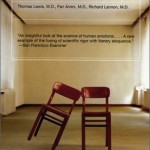 “A General Theory of Love” by Thomas Lewis MD, Fari Amini, MD, and Richard Lannon, MD, is all about why it’s so important that we are mammals. They say it’s vital that we value our mammalian attachment system and stay close to other mammals. Here are quotes and some great MP3 audio clips from “General Theory,” to follow up on Dr. Stephen Porges’ writings on our mammalian attachment system last week.
“A General Theory of Love” by Thomas Lewis MD, Fari Amini, MD, and Richard Lannon, MD, is all about why it’s so important that we are mammals. They say it’s vital that we value our mammalian attachment system and stay close to other mammals. Here are quotes and some great MP3 audio clips from “General Theory,” to follow up on Dr. Stephen Porges’ writings on our mammalian attachment system last week.
“A body animated only by the reptilian brain stem is no more human than a severed toe. Reptiles don’t have an emotional life,” says General Theory. “The advent of the mammalian limbic lobe, uniquely, allows mammals to care for their own, have emotions, and risk and lose life for another.”
“When mammals showed up on the planet, their method of reproduction was different. Unlike reptiles, they gave birth to live helpless young that had to be nurtured or wouldn’t survive,” said co-author Dr. Tom Lewis in a 2008 interview. “The parent had to monitor the physiology of the baby.
“This lead to the development of a part of the brain called the Limbic Lobe, which we share with all mammals. Infants’ physiology is incomplete on its own; babies can’t get to sleep on their own, they need to be lulled to sleep; they can’t soothe themselves, instead they seek out someone who can soothe them.
“Just as infants need the regulating presence of the external contact figure, all of us are like infants, only bigger, and we also need the regulatory influence… Most people think their body is self contained, that sugar levels are monitored internally and so on, oxygen, hormones. It’s very surprising that this not true – there are physiological parameters regulated by other people outside own body.
“In our culture we construe loneliness as weakness, as a character defect… But it’s based on brain evolution; there’s no choice about it. Just as when you’re hungry, or low on water and feel thirst, loneliness is a real physiological feeling telling you you need something vital. It hurts so much because it’s important to your health.”
Love is the glue that keeps people and societies together, says Dr. Richard Lannon in a terrific series of mp3 clips of interviews by radio host Paula Gordon. He explains fundamental human biology which makes our connections to others fundamental.
He relates the mammalian brain’s limbic system to being alive, to parenting, to being happy, to appreciating beauty and explains why we cannot “think our way” to fulfillment: http://www.paulagordon.com/shows/lannon/mp3/RLannonConv2.mp3
Dr. Lannon says it is good mothering which leads to secure attachment and explains the profound implications of the importance of optimally tuning in to a child. He describes how the ideas in General Theory of Love expand on (as well as part company from) traditional psychotherapy.
He reviews the profound, central importance of long-term, sustaining support networks for humans. He notes that most social forces currently work in the opposite direction:
http://www.paulagordon.com/shows/lannon/mp3/RLannonConv3.mp3
Dr. Lannon explains why self-help books usually are no help. He distinguishes General Theory of Love from that genre, explaining why we cannot intellectually (neocortex) control our emotions (in the limbic brain.) He argues for integration of the different ways of knowing – thinking neocortex and emotional limbic – urging us to give the limbic system its due – while pointing to the terrible social price we are paying for not doing so.
He describes what happens when people do not attach, personally and in society. http://www.paulagordon.com/shows/lannon/mp3/RLannonConv4.mp3
Humans have been given the gift of being a social animal, says Dr. Lannon, who urges us to be more of what we are. He reminds us that emotions are innate and that we all have them and must “tune” them, comparing this to tuning an instrument.
He describes humans as open-loop systems, deeply affected by our relationships with other and NOT independent of each other. He expands on, “We create each other.” He assures us that we can change, but only with the help of other people. He reminds us of the tremendous power social interactions have to heal, reminding us of research which shows that brains continue to grow into old age. http://www.paulagordon.com/shows/lannon/mp3/RLannonConv5.mp3
————————-
Kathy’s news blogs expand on her book “DON’T TRY THIS AT HOME: The Silent Epidemic of Attachment Disorder — How I accidentally regressed myself back to infancy and healed it all.” Watch for the continuing series each Friday, as she explores her journey of recovery by learning the hard way about Attachment Disorder in adults, adult Attachment Theory, and the Adult Attachment Interview.
Footnotes
FN1 Lewis, Thomas, MD; Amini, Fari, MD; Lannon, Richard, MD; “A General Theory of Love”, Random House, New York, 2000. See Dr. Lannon interviews at: www.paulagordon.com/shows/lannon/
Preface excerpts at: www.nytimes.com/books/first/l/lewis-love.html
On therapy: www.goodreads.com/author/quotes/1503539.Thomas_Lewis
![]()


